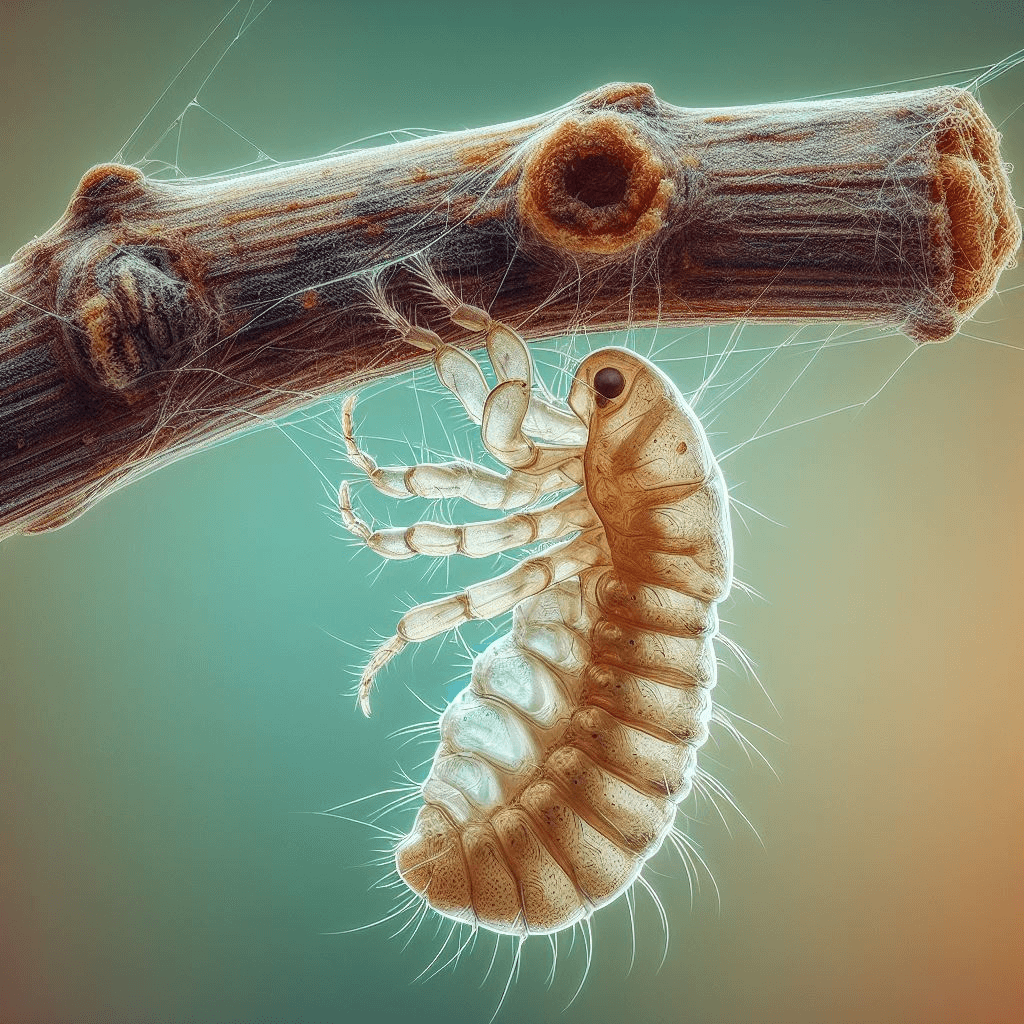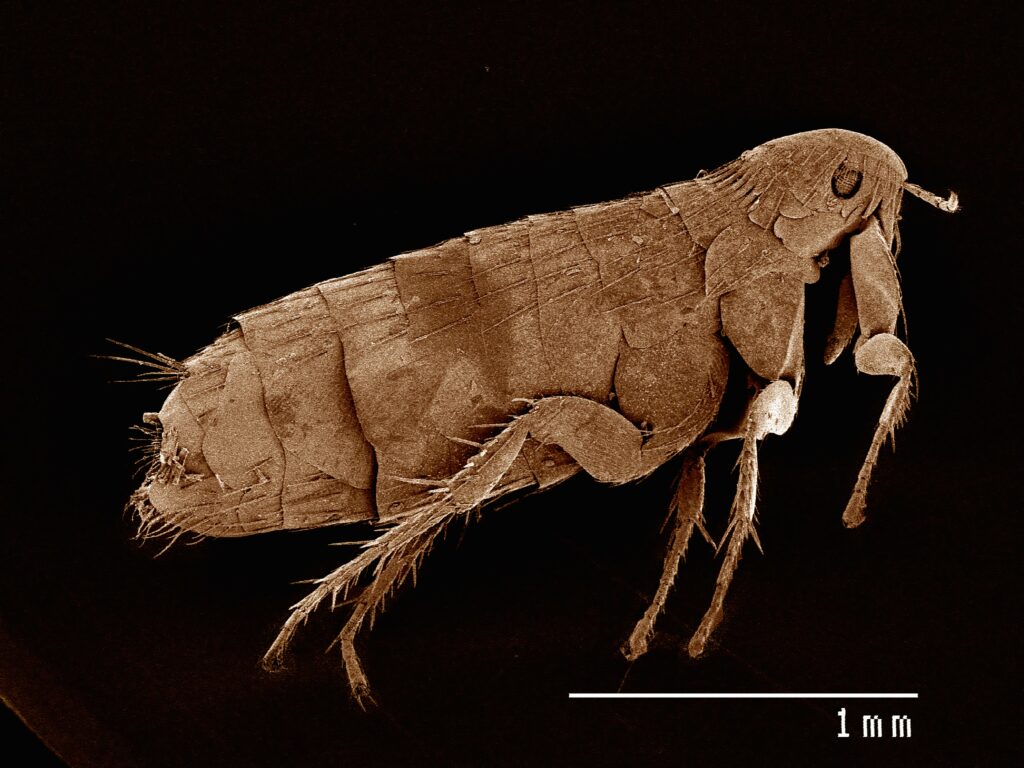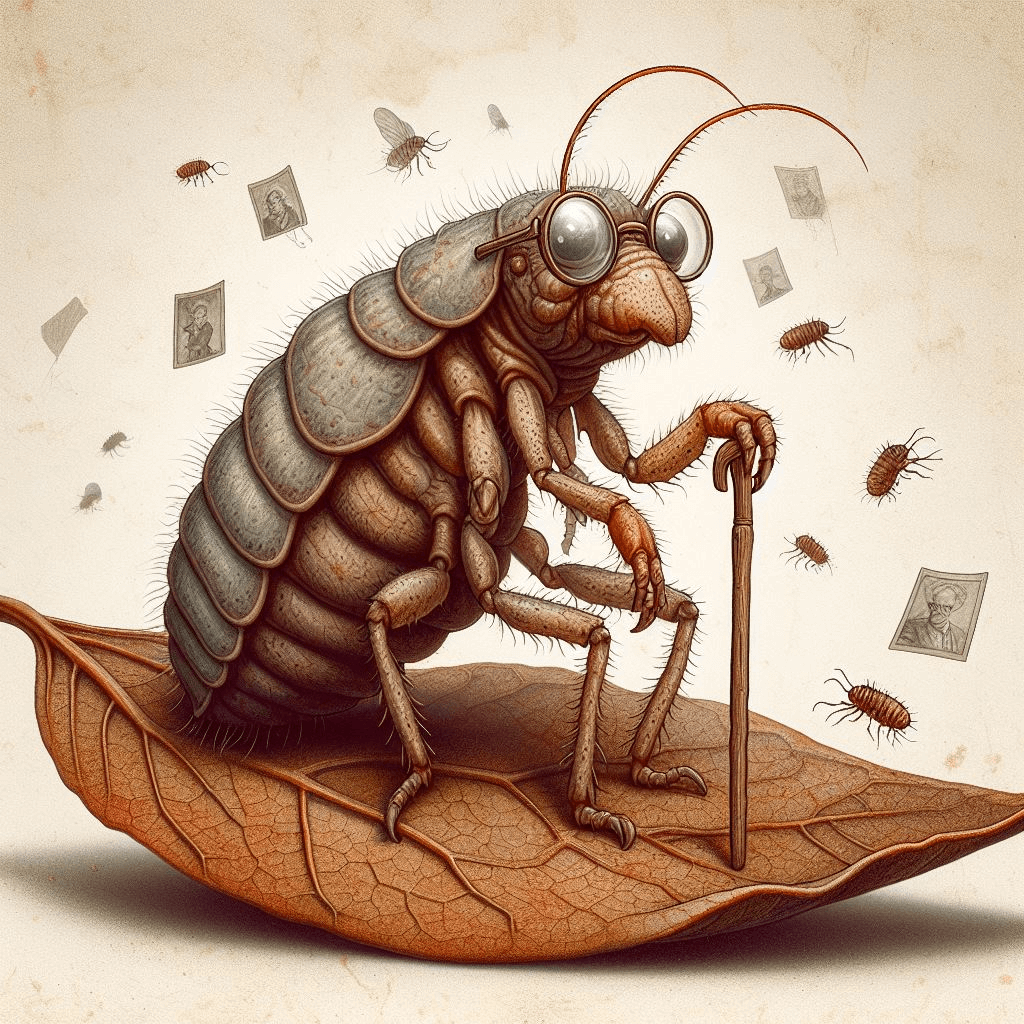Fleas, those tiny, blood-sucking creatures that seem to magically appear out of nowhere, are truly fascinating (and annoying) creatures. Classified as parasitic insects, these pesky critters belong to the order Siphonaptera and are known for their remarkable jumping abilities.
While they may be small in size, their impact can be mighty – causing discomfort and irritation for both humans and animals alike. When we think of fleas, we often associate them with our furry companions, such as cats and dogs.
However, it’s important to note that fleas can infest other animals like rodents and birds, making them quite versatile in finding a host. These wingless insects have specially adapted mouthparts designed for piercing the skin of their hosts in order to feed on their blood – talk about a gruesome meal!
Importance of understanding their lifespan
Understanding the lifespan of fleas is crucial when it comes to tackling flea control effectively. By comprehending how long these persistent pests can survive in our environment and on our pets or ourselves, we can implement appropriate pest control measures to prevent infestations and combat existing ones.
For instance, knowing that adult fleas live only about 2-3 months on average allows us to recognize the urgency in taking action against them. Additionally, comprehending the various stages within the flea life cycle – including eggs hatching into larvae that eventually transform into the pupae stage before emerging as adult fleas – provides insight into where we should focus our efforts for effective eradication.
Moreover, understanding flea lifespans helps us grasp why some traditional methods might not work as effectively as expected. For example, if you only treat your pets but neglect your home environment where flea eggs hatch and larvae may be hiding undetected, you’re simply allowing the cycle to continue.
By understanding the importance of addressing all stages of the flea life cycle, you can combat infestations more comprehensively. In the next sections, we will delve deeper into the stages of a flea’s life cycle and explore how environmental factors and host availability impact their longevity.
Understanding these intricacies will equip you with valuable knowledge to combat fleas more effectively and keep those pesky critters at bay. So, let’s jump right into it and uncover the secrets of these tiny but mighty creatures!
Lifespan of Fleas
Picture this: a tiny, bloodsucking insect hopping its way into your life. Ah, the humble flea!
These pesky critters have been around for centuries, and understanding their lifespan is crucial in combating their incessant presence. Generally speaking, fleas live for about 2-3 months on average.
But what are the factors that influence this fleeting existence? Let’s dive into the world of fleas and uncover the secrets behind their lifespan.
The Environmental Tug-of-War
Just like us humans, fleas are deeply impacted by their surroundings. Temperature and humidity serve as major influencers in determining how long these little buggers can remain a nuisance. Fleas thrive in warm and humid environments, with temperatures ranging between 70 to 85 degrees Fahrenheit (21 to 29 degrees Celsius) and relative humidity around 70 percent being ideal conditions for their survival.
If you’re dealing with fleas surviving a dry winter or arid climate, fear not! Flea pupae can survive up to one year in these harsh conditions until they find a suitable opportunity to emerge from hibernation.
A Hostile Takeover
Imagine being stuck on an island with no access to food or water—sounds dreadful, doesn’t it? Well, fleas feel the same way when they’re unable to find a host. Availability of hosts plays a significant role in determining how long these pests stick around.
Pets like cats and dogs serve as magnets for flea infestation since adult fleas often prey on them due to easy access through their fur-rich bodies. Humans can also become unwitting hosts if pets aren’t readily available.
Did you know that adult female fleas need blood meals before they can start laying eggs? In fact, an adult female flea can consume up to 15 times her body weight in blood every day.
That’s like a human devouring 1,500 hamburgers in a single sitting! So, if you want to eliminate fleas from your home or pets, cutting off their food supply is crucial.
The Flea Food Chain
You may be wondering how fleas find their next meal. Well, it turns out that fleas have quite the nose for detecting CO2 emissions and body heat. These clever insects can sense these signs from up to 50 feet away!
Once they locate their prey, they jump with incredible precision using their powerful hind legs and latch onto the poor host. The good news is that flea bites won’t cause long-term harm to most humans or animals; however, they can lead to itching and discomfort.
Wouldn’t it be convenient if we could wear little flea collars ourselves? Imagine never having to worry about those pesky bites again!
The lifespan of fleas ranges from about 2-3 months. This duration is influenced by various factors such as environmental conditions (temperature and humidity), availability of hosts (pets and humans), and access to blood meals.
Understanding these elements gives us valuable insights into how long fleas live and helps us tackle the perennial flea issue with better strategies. Stay tuned as we explore further into the intricate world of these tiny yet persistent creatures in our quest for knowledge!
Stages in the Flea Life Cycle
Egg Stage
Flea eggs are a crucial part of the flea life cycle. They are minuscule, about 0.5mm in length, and barely visible to the naked eye. The duration of the egg stage varies depending on environmental conditions.
Under favorable circumstances, flea eggs can hatch within 1-10 days. However, when conditions are less ideal, such as during colder temperatures or low humidity, the development of flea eggs hatch may take longer.
Ideal conditions for egg development are warm and humid environments. Fleas thrive in temperatures between 70-85 degrees Fahrenheit (21-30 degrees Celsius) with humidity levels around 70%.
These conditions allow flea eggs to mature and hatch as fleas reproduce more successfully. Pet bedding, carpets, and other cozy spots where pets rest become favorable locations for fleas to lay their eggs.
Larval Stage

Flea larvae emerge from hatched eggs and look like tiny worms with a whitish appearance. They measure approximately 1-5mm in length. During this stage of their life cycle, fleas have strong survival instincts and will avoid light by hiding in dark areas such as cracks, crevices, or pet bedding.
The primary goal of flea larvae is to find food sources to nourish themselves before progressing further into adulthood. Their diet consists mainly of organic matter such as dead skin cells or food particles left behind by pets or humans.
Larvae prefer warm and moist environments for development. Common hiding places include carpet fibers, soil around outdoor areas frequented by pets, or even within vacuum cleaner bags where they might escape suction due to their small size.
Pupal Stage

The pupal stage marks a significant transformation in the flea life cycle—an important step towards becoming an adult flea capable of reproduction. During pupation, flea larvae encase themselves in a protective cocoon made of silk and surrounding debris.
This cocoon acts as a shield against external threats and provides insulation during development. The pupal stage typically lasts between 5-14 days, but it can vary depending on environmental conditions.
The transformation from a larva to a pupa occurs within the cocoon. Inside, the immature flea undergoes complex physiological changes, gradually developing the structures necessary for it to emerge as an adult flea capable of seeking out a host.
Emerging Adult Fleas

Once the pupal stage is complete, adult fleas remain dormant inside their cocoons until stimulated by certain factors that indicate the presence of potential hosts nearby. The emergence of one flea from the pupae is triggered primarily by vibrations and increased carbon dioxide levels associated with movement and breathing. This means that newly emerged adult fleas are more likely to jump onto passing animals or humans rather than remaining in their cocoons for extended periods.
The duration between pupation and emergence can vary depending on environmental conditions, ranging from just a few hours to several weeks. Factors such as temperature, humidity, and host availability influence this timing.
To increase their chances of survival and finding a host, adult fleas possess remarkable adaptations. They have strong legs designed for jumping abilities up to 50 times their body length.
Additionally, they are equipped with sharp mouthparts that allow them to pierce through the skin and obtain a blood meal from their host. Understanding the various stages in the flea life cycle sheds light on how these resilient parasites survive and reproduce.
From eggs to larvae to pupae before finally emerging as adults, each phase presents unique challenges for effective flea control measures. By targeting all stages of this life cycle of a flea, and implementing proper prevention techniques like regular cleaning routines and appropriate use of flea control products such as collars or treatments recommended by veterinarians, one can effectively eliminate fleas and safeguard the well-being of both pets and humans.
Factors Influencing Flea Longevity
When it comes to adult fleas, their diet plays a crucial role in determining their longevity.
These miniature vampires rely on blood meals to not only survive but also reproduce. Adult fleas have specially adapted mouthparts designed for piercing the skin of their hosts, such as our beloved pets or even us humans.
Once attached, they feast on the blood that flows beneath the surface. This dietary requirement ensures they receive essential nutrients and proteins vital for their survival.
The role of blood meals in flea survival and reproduction is undeniable. Without regular access to a host’s blood, adult fleas cannot sustain themselves and eventually perish.
In fact, female fleas need a sufficient amount of nutrition from these meals to lay eggs – up to 40-50 eggs per day! It becomes clear that without a reliable food source, the adult flea population cannot thrive.
Impact of host availability on flea longevity
Host availability directly influences how long adult fleas can survive outside their cozy homes within your furry companions’ fur or your carpet fibers.
If there are plenty of hosts available – be it dogs, cats, or even long-haired animals like rabbits – fleas can hop from one warm body to another in search of sustenance. When there is an abundance of potential hosts around, flea populations thrive and persist for longer periods.
However, if these pint-sized creatures find themselves without a host for an extended period, survival becomes challenging. Hunger gradually weakens them until their bodies succumb due to lack of sustenance.
It’s worth noting that even when hosts are scarce or unavailable temporarily (say during vacation), some resilient adults can survive up to several weeks without feeding before desperation takes its toll. It’s a constant battle for survival in the world of fleas, where host availability determines whether they flourish or wither away.
Environmental conditions
Fleas are not just at the mercy of their blood-sucking tendencies and host availability; their longevity is also highly influenced by environmental conditions. Temperature and humidity levels play significant roles in determining how long these pesky parasites can endure.
Effects of temperature and humidity on flea survival cannot be overstated. Fleas prefer warm and humid environments, thriving best when temperatures range between 70-85 degrees Fahrenheit (21-29 degrees Celsius) and relative humidity stands around 70%.
In such favorable conditions, the life cycle of fleas accelerates, allowing them to complete transformations from eggs to larvae and to pupae more rapidly. However, when environmental factors become unfavorable – either too hot or too cold, excessively dry or damp – fleas face a challenging battle for survival.
Extreme temperatures can lead to desiccation or freezing, while low humidity inhibits proper development and hatching of eggs. But fear not – these resilient creatures have evolved adaptations that allow them to withstand harsh conditions and patiently await more suitable circumstances to emerge once again.
Adaptations to survive unfavorable environments
When it comes to surviving unfavorable environments, fleas possess some remarkable adaptations that enable them to bide their time until conditions improve. These tiny warriors have developed strategies for self-preservation during challenging periods when food sources are scarce or environmental factors are less than ideal.
One such adaptation is the ability of flea pupae – the cocoon-like transitional stage between flea larvae feed them and adults – to go into a state of dormancy known as diapause. Diapause happens when immature fleas stay inside their protective cocoons until they sense favorable circumstances surrounding them.
They can remain in this dormant state for weeks, months, or even years, patiently waiting for the opportune moment to emerge when the environment is more conducive to their survival. Interestingly, flea pupae also have a remarkable ability to detect vibrations and heat emitted by potential hosts.
This allows them to sense when a suitable animal comes near, triggering their emergence. Once stimulated by the presence of a host, adult fleas promptly emerge from their cocoons ready to jump into action and embark on another bloodsucking adventure.
Factors influencing flea lifespan and longevity are intertwined with their dietary requirements, host availability, and environmental conditions. Blood meals obtained from hosts directly impact adult flea survival and reproduction.
While access to hosts determines their overall population dynamics and ability to persist over time. Environmental conditions, particularly temperature and humidity levels, play a crucial role in shaping flea survival rates and developmental stages.
However, fleas have not just survived but thrived by evolving impressive adaptations that allow them to ride out unfavorable circumstances until better times arise. So next time you find yourself fighting a persistent flea issue or pondering how long these resilient creatures can endure – remember that understanding these factors is key to outsmarting our elusive foes.
Lifespan Variations Among Different Flea Species
When it comes to fleas, there are a few common types that tend to infest our beloved pets and sometimes even us humans. Two of the most prevalent species most fleas are cat fleas (Ctenocephalides felis) and dog fleas. These tiny creatures may seem insignificant, but they can cause quite a nuisance if left unchecked.
Cat fleas (Ctenocephalides felis)
Cat fleas, scientifically known as cat fleas or Ctenocephalides felis, are the most common type of flea found on both cats and dogs. Despite their name, they infest a wide range of warm-blooded animals including humans. These agile insects have a reddish-brown color and measure about 1-2 millimeters in length.
Adult female cat fleas lay their eggs on their host (your pet) which then fall off into the environment. They have an impressive ability to jump long distances and can bite people as well.
Dog fleas
Dog fleas, also known as Ctenocephalides canis, are a flea problem that primarily infest dogs but can also affect other animals including cats or even humans in some cases. These dark brown parasites have a similar size to cat fleas but are more commonly found on dogs with longer hair or in outdoor environments. They go through the same life cycle stages as other flea species: egg, larva, pupa, and adult.
Conclusion
Flea infestations can be quite bothersome for both our furry friends and ourselves. Understanding the lifespan variations among different flea species is crucial for effective prevention and treatment strategies against these pesky critters. Cat fleas (Ctenocephalides felis) are the most widespread, capable of infesting both cats and dogs, as well as humans.
They are agile jumpers and can cause discomfort with their bites. Dog fleas (Ctenocephalides canis), on the other hand, primarily target dogs but can still affect other animals or humans in certain circumstances.
To combat flea issues, it’s important to implement preventative measures such as regular grooming, using flea collars or treatments recommended by your veterinarian, and keeping your living spaces clean. Vacuuming floors and furniture regularly can help remove eggs, larvae, pupae, and even adult fleas that may be hiding in your home.
It’s also a good idea to empty vacuum cleaner bags outside to prevent reinfestation. Remember that fleas live for around 2-3 months on average but can be influenced by environmental conditions.
By tackling flea infestations promptly and consistently throughout their life cycle stages using appropriate insect growth regulators or professional services if necessary, you can minimize the impact of these tiny pests on your household. Stay proactive and make flea control a part of your routine pet care practices, ensuring the health and well-being of your beloved companions.
Banish fleas with D-Termination: Las Vegas’ top-notch pest control service!

If you’re contending with flea problems on your Las Vegas property, D-Termination is your solution. Our skilled team excels in eliminating flea infestations and restoring comfort and peace to your space. Bid farewell to fleas—choose D-Termination for effective pest control today!
Contact us at 702-919-6310 or visit dtermination.com to book your flea control service and reclaim your space from these pesky pests.
Frequently Asked Questions:
Fleas can live for several weeks to months in a house, depending on environmental conditions.
Fleas may not die on their own quickly; intervention is often necessary for effective elimination.
Fleas might not fully go away without proactive measures to eliminate them.
Quick methods to get rid of fleas in your house include using flea sprays, vacuuming, washing pet bedding, and treating your pets for fleas.








